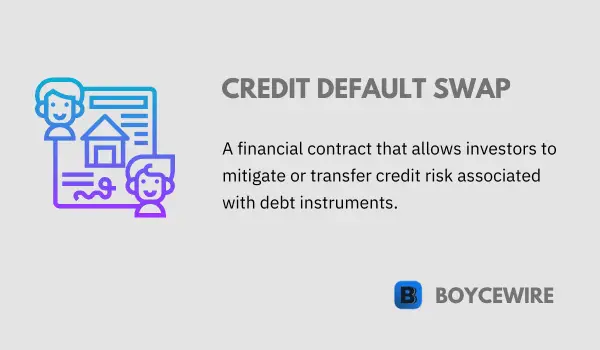Credit Default Swap: Definition, Pros, Cons & Examples

What is a Credit Default Swap?
In the complex and ever-evolving world of finance, various instruments are created to manage risk and optimize returns. Among these instruments, credit default swaps (CDS) hold a significant place due to their unique ability to isolate and trade credit risk.
A credit default swap is a financial derivative that allows an investor to mitigate the risk of a bond’s default. In essence, it is a type of insurance policy, where one party pays premiums to another party in exchange for a payout if a particular credit instrument defaults or experiences a similar negative credit event.
This financial tool has gained notoriety for its role in the 2008 financial crisis, yet it remains a critical component in the global financial landscape.
Key Points
- A credit default swap (CDS) is a financial derivative that provides protection against the risk of default on a debt instrument.
- It involves two parties, the buyer and the seller, where the buyer pays premiums to the seller in exchange for protection.
- If a credit event occurs, such as a default or restructuring, the seller compensates the buyer for the loss.
Understanding Credit Default Swaps
A credit default swap (CDS) is a financial derivative used to manage the risk of credit default, or the failure to meet debt obligations. The concept behind CDSs can be compared to insurance, where the purchaser of the CDS makes periodic payments to the seller, and in return, the seller agrees to compensate the buyer if a specific credit instrument defaults or experiences a defined negative credit event.
To better understand CDSs, let’s break down the parties involved:
- Protection Buyer This is the entity that purchases the CDS. The buyer could be a bond investor looking to hedge the risk of default on a particular debt security. The buyer pays a periodic fee, known as a spread, to the protection seller over the length of the contract.
- Protection Seller The seller of the CDS contract agrees to compensate the buyer in the event of a default. The seller collects the spread from the buyer and bears the risk of the reference entity defaulting.
- Reference Entity This is the entity whose default risk is being transferred. It can be a company, a government, or a complex debt instrument. It’s important to note that the reference entity is not a party to the CDS contract.
The specific terms, such as the definition of a credit event, the calculation of the settlement amount, and the contract duration, are all explicitly stated in the CDS contract. CDS contracts can be traded, and their value can fluctuate based on the perceived risk of the reference entity and market conditions.
CDSs have become an essential tool for banks, hedge funds, and other financial institutions to manage and speculate on credit risks. However, they also add a layer of complexity to the financial system and can contribute to systemic risks if not properly managed, as was evident in the 2008 financial crisis.
History of Credit Default Swaps
Credit Default Swaps (CDS) are a relatively recent financial innovation. They emerged in the mid-1990s as a tool for banks to manage their credit risk exposure.
- Early Development The first CDS was reportedly structured by Blythe Masters, a managing director at J.P. Morgan, in 1994. The goal was to remove risk from the bank’s balance sheet by transferring the credit exposure of the bank’s loan portfolio to another party. This initial CDS allowed J.P. Morgan to maintain relationships with loan clients while managing their risk exposure effectively.
- Growing Popularity Over the next decade, the use of CDSs expanded rapidly. Banks, insurance companies, and hedge funds all began to use them, both for hedging purposes and for speculation. This period saw an enormous growth in the credit derivatives market, with CDSs at the center.
- The 2008 Financial Crisis The role of CDSs in the 2008 financial crisis brought them to the forefront of public attention. The crisis highlighted some of the dangers associated with CDSs, particularly when used for speculation rather than hedging. The most infamous example was the insurance company AIG, which had sold a large number of CDS contracts without adequately hedging their risk. When the housing market collapsed, AIG couldn’t cover the losses, leading to a government bailout.
- Post-Crisis Reforms Following the financial crisis, regulatory bodies around the world introduced reforms aimed at increasing transparency and reducing risk in the derivatives market. A significant part of these reforms was the implementation of centralized clearinghouses to reduce counterparty risk and improve market stability.
Today, the CDS market continues to evolve in response to changes in regulatory environments, market dynamics, and technological advancements. The tool is still widely used for risk management, but with greater awareness of the potential systemic risks they can pose.
How Credit Default Swaps Work
At its core, a credit default swap (CDS) is a financial derivative contract that provides insurance against the risk of a default by a particular company (the reference entity). Here’s a breakdown of the key components and how they interact:
- Parties The CDS contract is between two parties – the buyer of protection and the seller of protection. The buyer of protection is trying to insure against the risk of default of a particular credit asset, such as a bond. The seller of protection is effectively providing insurance and taking on the risk of default.
- Payments The buyer of protection pays a periodic fee, known as the CDS spread, to the seller of protection. This payment continues over the life of the contract, which typically ranges from one to ten years. The spread is expressed in basis points (bps) of the notional amount that’s being protected.
- Credit Event If the reference entity does not default, the protection seller keeps the premiums paid by the protection buyer and no further payments are made. However, if a ‘credit event’ occurs (e.g., the reference entity defaults, declares bankruptcy, or undergoes a significant restructuring), the seller of protection is required to compensate the buyer.
- Settlement Upon a credit event, the contract can be settled in one of two ways. In a physical settlement, the protection buyer delivers a defaulted asset to the protection seller in exchange for the notional amount of the contract. In a cash settlement, the protection seller pays the protection buyer the difference between the notional amount of the contract and the recovery value of the defaulted asset.
In essence, a CDS is a kind of bet on whether a company will default on its debts. It’s a critical tool for banks, hedge funds, and other financial entities to manage their exposure to credit risk, but it can also be used for speculative purposes.
Types of Credit Default Swaps
Credit Default Swaps (CDS) are complex financial instruments with various types and structures to cater to the diverse needs of investors and financial institutions. Here are some of the main types of CDS:
- Single-Name CDS This is the most straightforward type of CDS. It involves a protection buyer and a protection seller with a contract focusing on a single reference entity. If the reference entity defaults, the protection seller will compensate the buyer according to the terms of the contract.
- Basket Default Swap This is a type of CDS where the contract is tied to multiple reference entities. The basket can contain various types of credit assets. A payout occurs when the first or nth credit event occurs, depending on the contract (first-to-default or nth-to-default swap).
- Index CDS Also known as a CDX in North America or iTraxx in Europe and Asia, these swaps are tied to a benchmark index, which usually consists of a diversified portfolio of companies. They provide a broad measure of the credit market’s sentiment and health.
- Total Return Swap In this type of CDS, the protection seller receives the total return (including interest payments and capital gains/losses) from a reference asset and in return, pays the buyer a predetermined rate. This allows the protection buyer to hedge against the risk of the reference asset’s value falling.
- CDS on Asset-Backed Securities (CDS of ABS) A CDS of ABS is a contract that provides credit protection for asset-backed securities. The protection buyer in this agreement pays a premium to the protection seller until the credit event occurs or the contract expires.
- Sovereign CDS These are contracts that are tied to sovereign debt, i.e., the debt of a national government. They function in the same way as a single-name CDS, but the reference entity is a country rather than a company.
Different types of CDS allow participants in the financial market to hedge or speculate on a wide array of credit risks, thus contributing to the overall efficiency and liquidity of the market.
Disadvantages of Credit Default Swaps
While credit default swaps (CDS) can provide significant benefits such as risk transfer and liquidity enhancement, they also come with several drawbacks and risks:
1. Counterparty Risk
This is the risk that the seller of protection will not fulfill its obligation in the event of a credit event. This risk was painfully demonstrated during the 2008 financial crisis when major protection sellers like Lehman Brothers and AIG defaulted on their obligations.
2. Systemic Risk
By spreading risk throughout the financial system, CDS can contribute to systemic risk. If one major party defaults, it can lead to a chain reaction of defaults, threatening the stability of the entire financial system.
3. Lack of Transparency
The CDS market is primarily an over-the-counter (OTC) market, meaning transactions are conducted privately between parties. This can lead to a lack of transparency and difficulty in pricing, which could exacerbate systemic risks.
4. Speculation and Moral Hazard
CDS can be used for speculative purposes, which can inflate the size of the market beyond the value of the underlying bonds. Furthermore, it can lead to moral hazard, as those insured against loss may have less incentive to evaluate the creditworthiness of the protection seller or the underlying credit.
5. Complexity
Understanding and pricing CDS can be complex, requiring advanced financial knowledge and modeling capabilities. Misunderstanding of these products can lead to poor investment decisions.
6. Regulatory Challenges
Due to their nature and risks, CDS often pose significant regulatory challenges. Regulators struggle to effectively oversee the market and to implement rules that maintain its benefits while mitigating its risks.
7. Legal Risk
CDS contracts involve intricate legal documentation, and the definition of a credit event can sometimes be ambiguous, leading to disputes between the buyer and seller of protection.
Advantages of Credit Default Swaps
Credit Default Swaps (CDS) are financial derivatives that provide protection against the risk of a debt issuer defaulting. They operate like an insurance policy, where the buyer of the CDS receives a payout from the seller if the issuer defaults on its debt obligations. Here are several advantages of using CDS:
1. Risk Management
One of the main advantages of CDS is that they allow investors to manage credit risk effectively. By buying a CDS, an investor can hedge against the risk of a bond or other debt instrument defaulting. This allows the investor to diversify their portfolio and reduce potential losses.
2. Liquidity and Price Discovery
CDS can also contribute to market liquidity and price discovery. They are often more liquid than the bonds they insure, making it easier for investors to buy and sell protection. Additionally, the price of a CDS can provide valuable information about the market’s perception of a debt issuer’s credit risk.
3. Profit Opportunities
For knowledgeable investors, CDS can offer profit opportunities. If an investor believes that a particular issuer’s credit risk is mispriced in the market, they can use CDS to bet on their assessment. For example, if an investor believes a company’s risk of default is higher than the market’s perception, they could profit by selling CDS contracts on that company’s debt.
4. Flexibility
CDS provide investors with flexibility. They can be used to create synthetic exposure to an issuer’s credit risk without having to buy or sell the underlying bond. This can be useful for investors who want to hedge or take on credit risk but face constraints in the bond market.
5. Lower Transaction Costs
The transaction costs for trading CDS are generally lower than those for buying or selling the underlying bonds, making CDS a cost-effective way to trade credit risk.
Examples of Credit Default Swaps
To solidify understanding of credit default swaps, let’s look at a couple of examples:
1. Hedging Credit Risk
Let’s say a mutual fund owns $10 million worth of bonds issued by Company X. The fund manager is concerned about Company X’s credit risk and decides to buy a CDS to hedge this risk. The fund manager enters into a five-year CDS contract with a bank, paying an annual premium of 2% of the $10 million notional amount, or $200,000, for the CDS coverage.
If Company X defaults on its bonds during the five-year period, the bank will pay the mutual fund the loss on the bonds, which is typically the face value minus the recovery rate. If Company X does not default, the bank keeps the premiums.
2. Speculating on Credit Risk
In this example, a hedge fund believes that Company Y, a firm in a struggling industry, has a higher risk of default than currently reflected in the market. The hedge fund decides to profit from this belief by buying a CDS on Company Y’s debt.
If the hedge fund’s prediction proves correct and Company Y defaults, the hedge fund will receive a payout from the CDS seller, resulting in a profit. However, if Company Y does not default, the hedge fund will lose the premiums it paid for the CDS.
3. Creating Synthetic Bonds
An institutional investor wants exposure to a specific company’s credit risk but cannot directly buy its bonds due to regulatory constraints. Instead, the investor could create a synthetic bond by buying a risk-free treasury bond and a CDS on the desired company. The combined cash flows would mimic that of the company’s bond, allowing the investor to gain the desired exposure.
4. Arbitrage Opportunities
Suppose a savvy trader identifies a discrepancy between the credit spread of a corporate bond and the premium of a CDS for the same company. The trader could simultaneously buy the bond, and buy protection through a CDS. If the trader’s assessment is correct, and the credit spread of the bond converges with the CDS premium (the cost of insuring against default), they could profit from the difference.
FAQs
A credit default swap is a financial derivative contract that allows investors to protect against the risk of default on a particular debt instrument, such as a bond or loan.
In a credit default swap, the buyer pays periodic premiums to the seller in exchange for protection against the risk of default. If a credit event occurs, such as a default or restructuring of the underlying debt, the seller compensates the buyer for the loss.
Credit default swaps are primarily used by investors and financial institutions as a risk management tool to hedge against credit risk or to speculate on the creditworthiness of a particular entity.
Credit default swaps provide investors with a way to manage credit risk, diversify their portfolios, and potentially profit from changes in credit conditions.
About Paul
Paul Boyce is an economics editor with over 10 years experience in the industry. Currently working as a consultant within the financial services sector, Paul is the CEO and chief editor of BoyceWire. He has written publications for FEE, the Mises Institute, and many others.

Further Reading
 Black Market - A black market is an illicit market where goods, services, or currencies are exchanged in violation of legal regulations.
Black Market - A black market is an illicit market where goods, services, or currencies are exchanged in violation of legal regulations.  Producer Surplus: Definition, Formula & How to Calculate - The producer surplus is the difference between what the producer sells its goods for and the minimum price it would…
Producer Surplus: Definition, Formula & How to Calculate - The producer surplus is the difference between what the producer sells its goods for and the minimum price it would…  Demand Schedule - A demand schedule is a tabular representation that shows the quantity of a good or service that consumers are willing…
Demand Schedule - A demand schedule is a tabular representation that shows the quantity of a good or service that consumers are willing… 